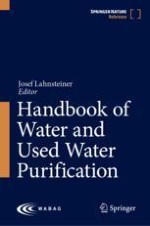
2024 | OriginalPaper | Chapter
1. Coagulation, Flocculation, and Precipitation in Water and Used Water Purification
Authors : Suraj Babu Pillai, Nitin Vitthalrao Thombre
Published in: Handbook of Water and Used Water Purification
Publisher: Springer International Publishing
Activate our intelligent search to find suitable subject content or patents.
Select sections of text to find matching patents with Artificial Intelligence. powered by
Select sections of text to find additional relevant content using AI-assisted search. powered by